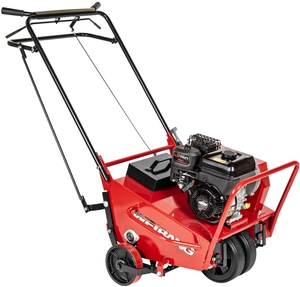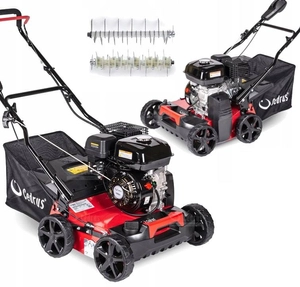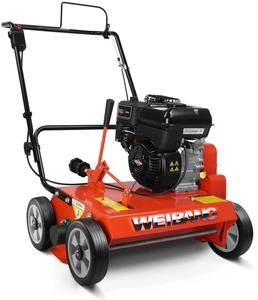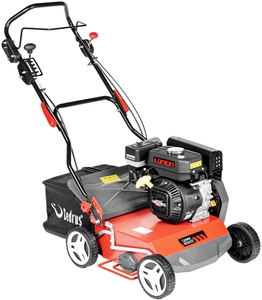How and when to use scarifiers to get the perfect lawn: A practical guide

Maintaining a healthy and attractive lawn requires more than regular mowing. One of the key maintenance procedures is scarification, a process that can significantly improve the condition of the grass. Scarification involves the mechanical removal of lawn felt and dead grass, which facilitates the penetration of air, water and nutrients into the grass root system. Here's a guide to help you understand how and when to use a scarifier to get the best results.
Benefits of scarification:
Regular scarifying brings many benefits to the health and aesthetics of the lawn, primarily by increasing the availability of air, water and nutrients for the grass root system. Removing felt and dead organic matter from the lawn surface not only improves soil permeability and reduces the risk of fungal diseases, but also stimulates the grass to grow thicker and more vigorously.
This makes the lawn more resistant to extreme conditions such as drought or heavy rainfall, and better able to cope with competing weeds. In addition, regular scarification can also contribute to a more even and durable green color of the lawn, which significantly enhances the overall aesthetics of the garden. Therefore, scarification is an invaluable tool in the hands of any gardener striving to maintain a healthy and attractive lawn.
- Improve access of air, water and nutrients to the roots - Removing the felt allows for better flow of air, water and fertilizer into the soil, which supports healthy lawn growth.
- Reducing the risk of diseases - Lawn felt is the perfect environment for diseases and pests. Its removal minimizes the risk of their occurrence.
- Stimulation of new shoot growth - Removing old, dead parts of the grass stimulates the lawn to regenerate and thicken, leading to a more lush appearance.
- Better drought tolerance - A lawn with less felt performs better in water-starved conditions because the root system has better access to underground resources.
The best time to scarify:
Choosing the right time to scarify is key to ensuring optimal conditions for lawn recovery and growth. The ideal periods for scarifying were in early spring and early autumn, when the grass is in the intensive growth phase and weather conditions are conducive to rapid recovery.
Spring scarification, preferably carried out between mid-April and early May, prepares the lawn for the growing season by removing the felt accumulated over the winter and facilitating access to nutrients.
Autumn scarification, recommended for September or early October, helps the lawn recover from the summer heat and prepares it for the coming winter months, providing better resistance to frost and other adverse conditions.
Thus, proper scheduling of scarification allows you to keep your lawn in excellent condition throughout the year, while minimizing the risk of damage or grass diseases.
- Spring - Spring scarification is ideal because the lawn recovers quickly in rising temperatures. It is best performed between mid-April and early May.
- Autumn - The second optimal time is the beginning of autumn (September-early October). The lawn will have time to regenerate before the onset of winter, while the temperature is still high enough for the grass to regenerate quickly.
Tips for choosing the right device
- Type of scarifier:
- Manual - best for small or medium-sized lawns where the user is willing to make a physical effort.
- Electric - Ideal for medium-sized lawns, require access to a power source.
- Combustion - Best for large lawns, provide more power and mobility.
- Working width - The larger working width means faster and more efficient coverage of large areas, but may be less practical in tight spaces.
- Working depth - The ability to adjust the working depth is key, as different types of lawns require different intensity of treatment.
- Tank capacity - if scarifier has a tank for extracted matter, it is important that it is large enough not to require frequent emptying.
How to use the scarifier
- Lawn preparation - Before scarifying, cut the lawn to a low height and make sure it is free of large stones and other objects that could damage the device.
- Depth setting - Adjust the scarifier so that it does not damage the healthy part of the grass, but effectively removes the felt and dead grass.
- Regularity of treatment - Usually one scarification per year is sufficient, but depending on the condition of the lawn, it may need to be repeated.
Scarifying is an essential treatment for anyone who wants to keep their lawn in excellent condition. Performing this treatment regularly will ensure a healthy, dense and green lawn that will be a highlight of any garden.
Check also: Submersible pumps and concrete mixers.
Recommended

WEIBANG WB457AB SPRINKLING TURBLE 5 HP B&S Briggs & Stratton 750 Series WB457 / WB 457 lawn aerator EWIMAX - OFFICIAL DISTRIBUTOR - AUTHORIZED WEIBANG DEALER

WEIBANG WB517AB SPRINKLING RUBBLE 5 hp B&S Briggs & Stratton 750Series WB517 lawn aerator EWIMAX - OFFICIAL DISTRIBUTOR - AUTHORIZED WEIBANG DEALER

WEIBANG WB384RB PROFI PROFESSIONAL STEADY COMPACT VERTICULATOR Briggs&Stratton WB384 WB 384 EWIMAX - OFFICIAL DISTRIBUTOR - AUTHORIZED WEIBANG DEALER

CEDRUS WR01 SPRELINER TREATER AREATOR 2-in-1 5.5 HP - EWIMAX - OFFICIAL DISTRIBUTOR - AUTHORIZED DEALER CEDRUS



